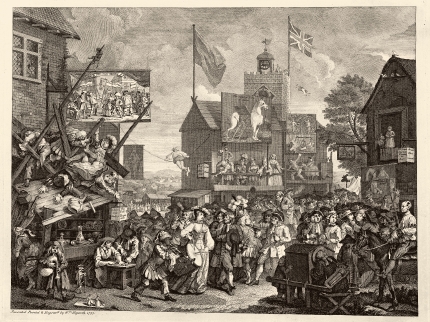Hogarth’s Southwark Fair at Tate Britain
William Hogarth's Southwark Fair is part of the major exhibition at Tate Britain staged on the 250th anniversary of the artist being appointed Sergeant Painter to George III.

The exhibition's co-curator Christine Riding highlights Southwark Fair as the epilogue to Hogarth's celebrated Rake's Progress where dissolute Tom Rakewell ends his life in the Bedlam madhouse surrounded by people acting out fantasy roles.
The Rake's Progess paintings, on loan from Sir John Soane's Museum, were completed just months after the painting of the 1732 Southwark Fair. The exhibition shows the engraving.
The annual fair took place around 8 September having originated as the patronal festival celebration of Southwark Priory – now the cathedral. So it's a surprise to find the Tate confirming that the church tower in the picture belongs to St George the Martyr in Borough High Street. This is probably the last depiction of the old battlemented tower before the church was demolished to make way for today's building.
The outdoor scene shows a peepshow and a collapsing stage where players are performing The Fall, a probable allusion to Tom Rakewell's fall into prison at Bedlam. One of the actors on the stage cloth looks suspiciously like Sir John Falstaff. (Elsewhere in the exhibition, the earliest surviving painting of a scene from a Shakespeare play is dominated by Falstaff.)
Music is provided by a man playing bagpipes and a boy with a trumpet. This young man is black and since black men in Hogarth's pictures are usually servants we may assume that this is a page enjoying a day off on the wrong side of the river.
Liberation is in the air with a prominent young woman playing a drum which could be a reminder that another name for the Southwark fair was the Lady Fair. This was derived from Our Lady whose birthday was the excuse for the original annual party.
The picture is appropriately displayed alongside a contemporary etching of Bartholomew Fair in nearby Smithfield which always preceded Southwark Fair by two weeks.
This is largely an exhibition about bad taste or extravagant behaviour in central London during the early Georgian period. Old London Bridge is the visible through the window in the final scene of the Marriage a la mode series. Other drawings attack the lottery and excessive drinking.
The portrait section includes a splendid depiction of Archbishop Thomas Herring who travelled from Lambeth Palace to Leicester Square to sit for Hogarth. The result is an animated figure which friends thought was too true to life. Hogarth only worked on people, places or events he knew really well.
• Hogarth is at Tate Britain, Millbank, daily until Sunday 29 April; admission £10 (conc £8).
• The catalogue (hardback £40; softback £29.99) includes the short essay by Christine Riding on Southwark Fair and a two page enlarged detail of the etching.
Comments
Share
The SE1 website is supported by people like you
More to read
- Hogarth's Southwark Fair on show at Cuming Museum 19 Nov 2007
- Southwark Fair at the National Theatre 17 Feb 2006
Related forum discussions
- None found. Why not start a discussion?
Follow us
Email newsletter
For the latest local news and events direct to your inbox every Monday, you need our weekly email newsletter SE1 Direct.

